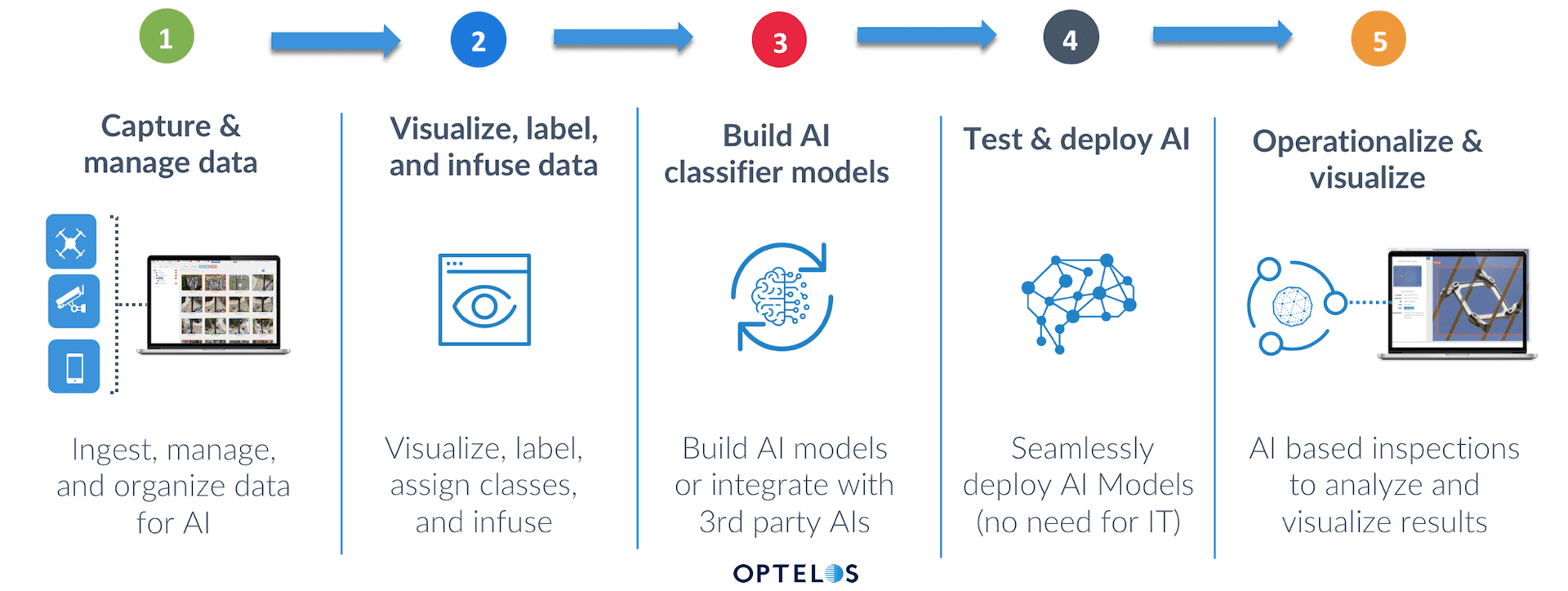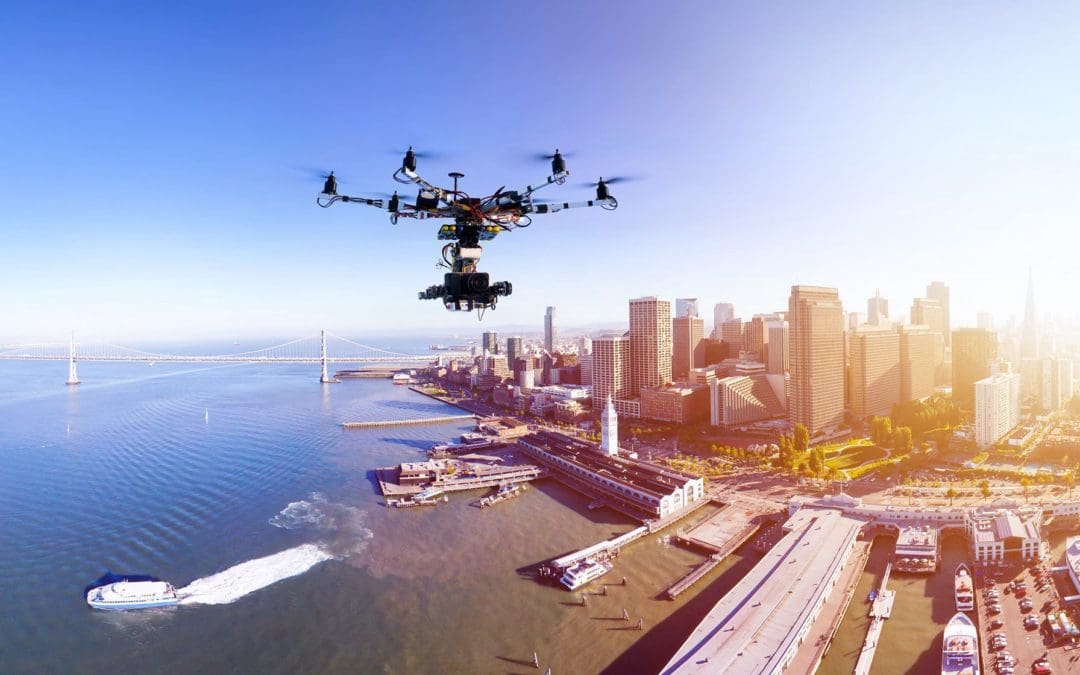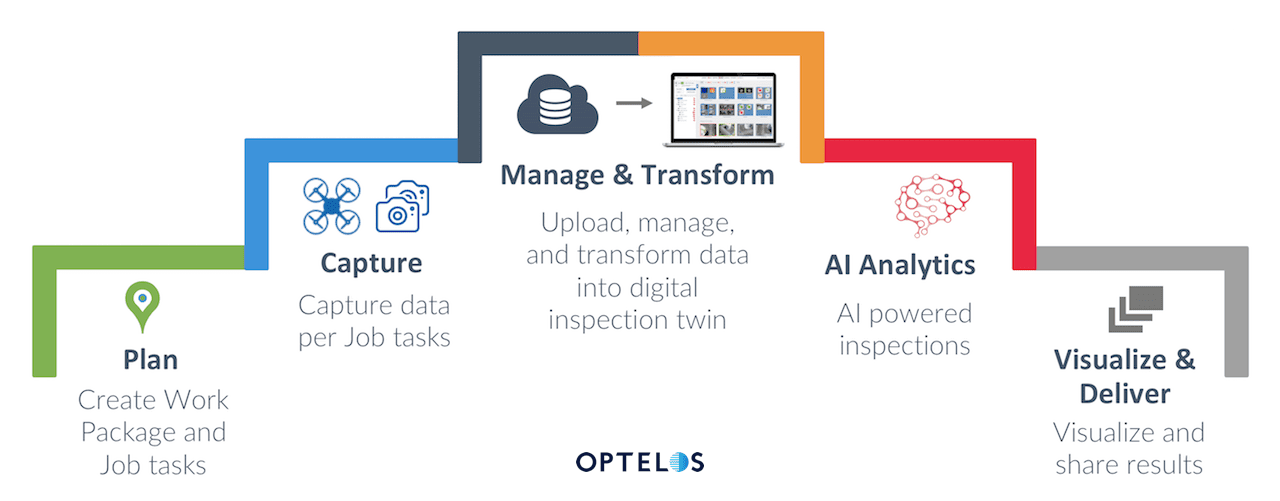Drone Inspection Data Management Workflow
With any drone program, we all understand that the real value comes from the data, what intelligence we can extract and how we action those insights into meaningful business direction. However, to achieve this there are a number of factors you must take into account, especially as your drone inspection program expands and ‘takes flight’.
A drone inspection program journey typically consists of the following steps:
Often times companies will begin their drone inspection program by utilizing separate point solutions to fly, capture, analyze and manually store that drone data. This initial step provides a relatively quick and simple way to start building the program and generating inspection data. But as organizations start to scale their program, they often realize that managing these disparate steps and point solutions is not feasible as the volume of data, users, and applications grow.
A Unified Data Management System Provides a Single Pane of Glass
Organizations will ultimately need a single pane of glass solution with which to store, manage, process, visualize, analyze and share all forms of data; whether this be visual, sensor, drone or non-drone information. As the program gains momentum, a unified platform allows multiple workgroups to interact and share their specific key insight from the data. Additionally, this may require different business units, regions, facilities and clients to action their workflow and procedures. Lastly, integration into existing dispatch, operational support systems, and business intelligence systems allows organizations to realize the full potential of the data.
Another key factor is the ability to share the data across the organization. Data management structure has to be at the core to any data journey otherwise we risk losing the value of the data and the drone program will not reap the rewards with which the initial investment was made. To capitalize and expand the program beyond an initial trial, a modular data management solution with the ability to ingestion all data must be at the heart of the strategic initiative.
A Modular Approach with Flexibility and Scalability
Of course, every organization is unique and not all companies need to employ every aspect of the drone inspection data management workflow out of the gate, either due to financial or strategic investment considerations. Therefore, a modular approach is required that meets the organization’s existing needs but allows for future growth. A solution that scales with the flexibility of your unique workflow and industry is paramount and with entry level deployments of the system available, a customized data structure can be created and evolved as you learn, alongside the program maturity and experience. This allows you to get the ‘basics right’ as you scale your program.
Limitations of DSP Software for Inspection Data Management
- Not a core capability: Providing best-in-class data management, data visualization, and analytics software is not the core business and expertise of the drone service providers (DSPs).
- Data Access and Program Scalability: Since these providers are motivated to retain their flight services, they offer a proprietary software solution, meaning that the Enterprises are “locked” into the service providers. This means their valuable and confidential data was controlled by a single service provider, making it very difficult to scale.
- Over-reliance on a Single Provider: Additionally, relying on a single drone service provider meant that Enterprises did not have the flexibility to use multiple providers or eventually bring the drone inspections in-house due to the proprietary nature of the service provider’s software.
From: Robust data structures, workflows, data capture from any device and type, job allocation and dispatch, and user management.
Into: The required end deliverables such as 3D reality models, annotations, definable reports, geolocation of issues, trouble ticketing, severity levels, searchable metadata across asset portfolios, and AI powered analytics.
Once these fundamental data management lessons have been learned and company buy-in reflects the potential of the data and the strategic objectives this drives, the next steps by definition needs to be customizable to your particular organization. This is where the modular approach enables growth tailored to your direction. This usually entails faster analytics, integration into other established workflows and software and deployable across the organization to allow the ability to act on the data.
Planning for the Future: an AI/ML-Capable Platform:
When the time is right, Artificial Intelligence and Machine Learning and (AI/ML) is another key modular platform capability that is fully integrated and available for implementation when you’re ready. Feedback indicates that as the inspection program grows, so does the data quantity, and very quickly this can get overwhelming. Therefore, adding a little help from AI can greatly reduce the workload by identifying just the select few images that require manual assessment, while increasing the quality of your insights.

Just as having a modular approach is important for managing, processing, and visualizing your data, providing a modular yet integrated platform to start your AI journey is equally important. This consists of 5 simple steps that any company can start to utilize:
- Upload & Manage – Whether you have team of data scientists employed, or you simply require one place to manage and analyze your data, you should implement a single platform that facilitates a seamless start-to-finish workflow. This enables a single source of truth for you act on that data whether it is for human expert analysis or AI assisted inspections.
- AI Labeling – Directly from the platform create AI labeled datasets ready for AI training. Whether it be for Image Classification, Object Detection or Segmentation use cases. All the tools are available to quickly and easily create any number of AI classifiers with any AI classes installed.
- Create the Classifier – Once your datasets are labeled, it is important to automate the delivery of the labeled datasets to any AI engine. This allows you to utilize your own AI engine, work with solutions such as Optelos’ AI Recognition, or other 3rd party AIs. The important thing is that the platform is open and able to deliver all the required data directly to create the AI algorithms for your AI Classifier.
- Deploy the AI – Once a Classifier is created or you have previously created AI classifiers, you need the ability to deploy these AI models directly within the platform, ideally with no need for IT or other development. This allows a complete ‘AI marketplace’ for you to share across the organization for each use case you have developed and integrate this back into the data management platform. This allows organizations to utilize AI classifiers from any vendor.
- Operationalize the AI – Automatically perform the AI classification to identify issues and infuse into existing visual data. This means the AI results are integrated to the workflow, such as the geolocation onto either a 2D map or allow you to place on a 3D Digital Twin of the Asset. This allows you to rapidly scale the amount of inspection projects by minimizing human analytics; saving both time and money. .
Data Visualization and Contextualization
Next, it is extremely important to provide a unified and immersive ‘360 degree view’ to visualize and act on all data into what we call a “single pane of glass”. This data consists of all types and is often very large and requires specialized tools to view. For example, an inspection project may contain a wide range of visual information that can include thousands of hi-resolution images, hours of 4K video, massive 3D models, and detailed 2D Orthomosaic maps that provide critical information about the asset. This single pane of glass allows users to see the relationships and context between the data, ensuring organizations do not lose valuable information and possibly miss critical issues.
Of course, it’s also important to deliver the highest quality and accuracy reality models to allow precise inspection, detection, and analysis. The visualization tools should seamlessly allow users to view a 2D map over time for change detection or interrogate a 3D model looking at measurements and attached imagery, videos, reports directly onto the Point Cloud. The results can be coupled into the AI to maximize the benefit of any file type.
Systems Integrations Improve Inspection Data Leverage and Automate Actions
Finally, no solution would be complete without the ability to interface into current back-office systems and business intelligence systems. This requires an open architecture platform that can deploy anywhere such as the cloud, secure cloud, under the firewall or hybrid deployments within the customer’s own Cloud. Integration into Enterprise Asset Management system, trouble ticketing software, Single Sign On solutions and other portals are also available as options to enhance the interactive nature of data. The APIs are customizable and available to ‘push and pull’ any data to whichever platform requires it.
In short, as organizations scale their program, having a unified visual data management platform enables your visual data to provide a 360-degree visibility into your most pressing asset inspection and maintenance needs. It allows you to transform data chaos into actionable insights, improving safety and efficiency at scale.


